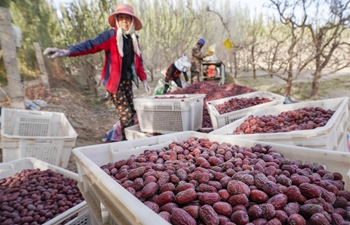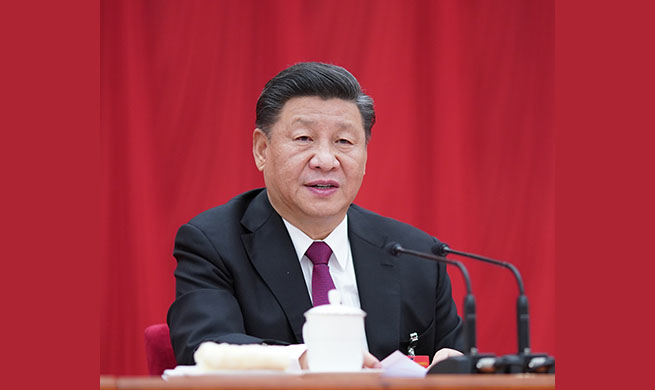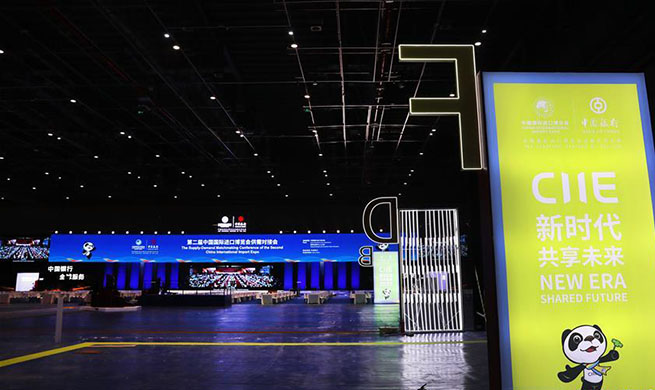BANGKOK, Nov. 1 (Xinhua) -- Negotiations of the Regional Comprehensive Economic Partnership (RCEP) and cooperation for regional connectivity are expected to top the agenda of the upcoming ASEAN summit and related summits, scheduled for Nov. 2-4 in Bangkok, Thailand.
ASEAN (the Association of Southeast Asian Nations) groups Brunei, Cambodia, Indonesia, Laos, Malaysia, Myanmar, the Philippines, Singapore, Thailand and Vietnam.
The summits come at a time when the world is facing increasing uncertainty and instability with unilateralism and protectionism on the rise. Participants will discuss cooperation plans and measures to enhance regional integration in efforts to uphold multilateralism amid global headwinds.
RCEP NEGOTIATIONS ENTERING FINAL STAGE
This year all eyes will be on RCEP, a proposed mega trade pact between 10 ASEAN member states and their six free trade partners, namely China, Japan, South Korea, India, Australia and New Zealand.
The seven-year negotiations have entered the final stage, with officials from a number of negotiating parties sounding an optimistic note of sealing the deal soon.
Once in operation, RCEP will become the world's largest free trade agreement, covering 32.2 percent of global GDP and 3.5 billion people, or almost half of the world's population. RCEP economies account for 29.1 percent of global trade and about one-third of global investment inflows.
Negotiators of the 16 countries have been engaged in a series of intensive talks through October before a planned RCEP summit in Bangkok on Nov. 4.
"RCEP will have a significant effect in shaping the present world economy by ensuring that more countries through a multilateral FTA still prefer or are committed to liberalized trade," Aaron Jed Rabena, a research fellow at the Manila-based think tank Asia Pacific Pathways to Progress Foundation, told Xinhua.
ASEAN, CHINA SYNERGIZING DEVELOPMENT PLANS
China and ASEAN adopted the landmark China-ASEAN Strategic Partnership Vision 2030 in November 2018, charting the future direction for the long-term development of ties. One year into the new course, both sides are expected to make fresh endeavor during the ASEAN-China summit to further dovetail development plans especially in forging regional connectivity.
Under the guidance of the China-ASEAN Strategic Partnership Vision 2030, the two sides will work together to synergize the China-proposed Belt and Road Initiative (BRI) with the Master Plan on ASEAN Connectivity 2025.
Noting that all 10 member states of ASEAN have respectively signed cooperation documents with China on the BRI, Chinese Ambassador to ASEAN Huang Xilian said he expected important achievements to be reaped during this year's summit in synergizing the BRI with ASEAN's development plans.
"We expect this year's 10+1 (ASEAN plus China) meeting to achieve new and fruitful results, send out positive signals and once again display the advancement and guiding strength of the China-ASEAN ties," Huang told Xinhua ahead of the summit.
ASEAN and China are also expected to roll out practical measures to enhance people-to-people exchange, deepen cooperation in digital economy, smart cities network and e-commerce, among others, according to the ambassador.
ASEAN COMMUNITY BUILDING GAINING FRESH IMPETUS
Since launching the ASEAN Community in 2015, the bloc has been striving to accelerate the integration of 10 member states by building on three pillars -- political-security community, economic community and socio-cultural community.
Over the past four years, ASEAN's norms and values of openness and inclusiveness have prevailed and thrived, according to Chheang Vannarith, president of the Phnom Penh-based Asian Vision Institute.
Main challenges for the ASEAN Community derive from the implications and impacts of the Fourth Industrial Revolution and climate change, increasing vulnerabilities of cyber space and digital economy, and the development gap between members, according to him.
Key topics at this year's ASEAN summit include industrial transformation for Industry 4.0, collective efforts to tackle climate change, digitalization of micro enterprises, advancing education for sustainable development, and the smart cities network -- a platform for cities across the bloc to work together towards smart and sustainable urbanization using technology as an enabler.
Launched in 1967, ASEAN currently has a combined population of over 649 million, accounting for about 8.5 percent of the world's total. In 2018, the region recorded a combined GDP of more than 2.9 trillion U.S. dollars, a growth of 5.2 percent, according to ASEAN statistics.













